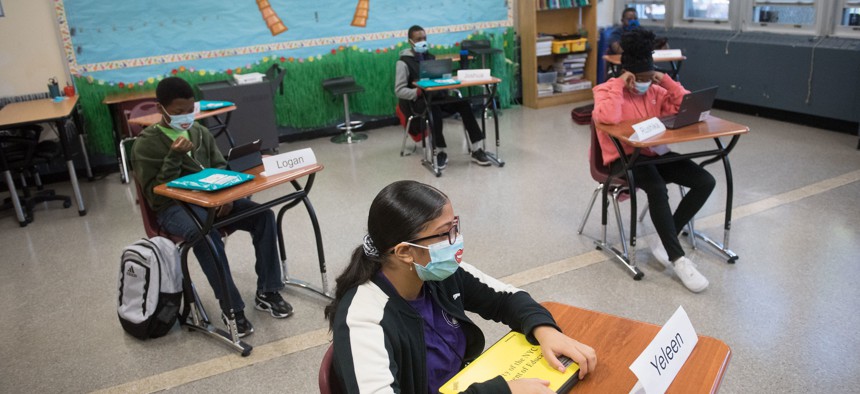Education
How Cuomo repurposed pandemic aid meant for schools
Without federal support for state and local governments, the governor dipped into funds meant for education.

Students at the One World Middle School at Edenwald in the Bronx. Michael Appleton/Mayoral Photography Office
Education is a huge part of New York’s budget, accounting for around a quarter of the state’s expenditures in normal years. Since the onset of the COVID-19 pandemic, however, the state has used an influx of federal dollars to supplant a portion of its aid to local school districts. Last March, the CARES Act allocated $1.2 billion toward education, and the December stimulus bill included nearly $4 billion. But the March package offset nearly one-to-one reductions in the state’s own aid – with total education spending remaining flat – and approximately half of the December assistance supplanted education spending in the executive budget proposal for the coming fiscal year.
Though the remainder of the December aid does represent a supplemental investment of approximately $2 billion, advocates claim that the federal assistance was not intended to replace the state’s own education spending.
“The federal package did not include any aid for state and local governments, so even though schools were getting a boost, there was no money for Gov. Andrew Cuomo to use just to close the state budget gap,” said Jasmine Gripper, executive director of the Alliance for Quality Education.
Critics of the state’s management of the federal aid argue that the additional funding was needed to keep schools running during the pandemic. Michael Mulgrew, president of the United Federation of Teachers, told City & State the federal aid was needed for personal protective equipment, ventilation upgrades and nightly cleaning, in addition to the costs associated with remote learning.
“Whenever we fight for aid, we hate when anything gets supplanted,” he said.
A spokesperson for Cuomo did not respond to a request for comment on the state’s use of the federal aid.
New York is currently facing a projected budget deficit of $60 billion over the next four years. The $2 billion supplemental portion of the December aid is slated to drive a 7.1% increase in total education spending in the proposed 2021-2022 budget – versus a typical annual increase of around 3% to 4% – which raises the possibility of a fiscal cliff once emergency assistance from Washington dries up.
In his executive budget for the coming year, Cuomo proposed two recurring actions that would result in aggregate reductions in education spending. The so-called Local District Funding Adjustment would reduce school aid by about $1.3 billion annually, and the Services Aid consolidation – which combines 11 expense-based aid categories into one – would yield around $700 million in recurring savings.
Under the proposed Local District Funding Adjustment, school districts that receive more funding from the state through the School Tax Relief, or STAR, program – which per capita tend to be wealthier districts – would see the steepest reduction in aid. Nevertheless, education equity advocates argue that the state has been underfunding public schools since the 2007 enactment of the Foundation Aid formula, following the landmark 2006 Campaign for Fiscal Equity ruling that found that New York was underfunding schools.
“Cuomo is choosing to balance the budget on the backs of Black, brown and low-income students by reducing the state’s commitment to education instead of what he should be doing, which is asking the ultrarich and New York’s billionaires to pay a little bit more,” Gripper said.
Both recurring reductions would have a significant impact on New York City, which operates the nation’s largest public school system. The Department of Education is the largest agency in the city’s budget, and a substantial portion of its funding comes from state aid. Given the particularly hard toll the pandemic has taken on New York’s business districts and retail sector, coupled with the explosion of remote work, it may take a while for property taxes – which constitute the city’s largest tax revenue stream – to rebound.
“The city is going to be facing this multiyear revenue hit on the property tax, which it has not had during prior recessions, and so its ability to fill in if state aid is lower – which is what they have usually done with their own resources – is going to be more constrained,” said Ana Champeny, director of city studies at the Citizens Budget Commission, a nonpartisan fiscal monitor.
As a fiscal crisis looms in New York, the Biden administration just finalized another round of stimulus funding. The bill includes $130 billion in education aid for schools to reopen.
With students having to make up for learning loss and, in some cases, suffering from emotional trauma, Mulgrew said the city would need the additional federal aid.
“Smaller class sizes definitely are going to have to be in place, and how do we start to help children who have been greatly harmed because of the pandemic?” he said. “It wasn’t fair, and the teachers are ready for that challenge, but you can’t tell us to take on this challenge with our hands tied behind our backs.”

NEXT STORY: Three issues to watch in state budget negotiations